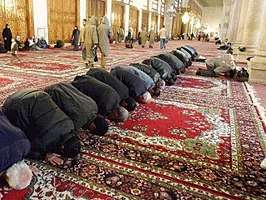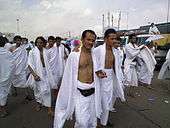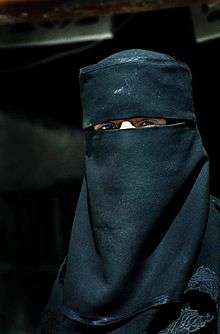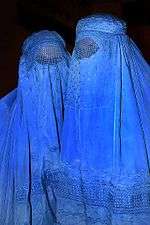Intimate parts in Islam
The intimate parts (Arabic: عورة 'awrah, Arabic: ستر, satr ) of the human body which must, according to Islam, be covered by clothing.[1][2] Exposing the intimate parts of the body is unlawful in Islam as the Quran instructs the covering of male and female genitals, and for adult females the breasts. Exposing them is normally considered sinful. Exposing intimate parts when needed, such as going to the toilet or bathing, falls under a specific set of rules. Precisely which body parts must be covered varies between different schools of Islamic thought. The Quran admonishes Muslim women to dress modestly and cover their breasts and genitals.[3] The Quran explicitly states that "O wives of the Prophet, you are not like anyone among women" (Quran 33: 32) and as such has separate rules specifically for the wives of the Prophet.[4]
| Part of a series on |
| Islamic jurisprudence (fiqh) |
|---|
 |
|
| Islamic studies |
 |
| Part of a series on |
| Islamic female dress |
|---|
| Types |
| Practice and law by country |
| Concepts |
| Other |
Etymology
In Arabic, the term 'awrah or 'awrat (عورة) derives from the root ‘-w-r which means "defectiveness", "imperfection", "blemish" or "weakness". However, the most common English translation is "nakedness".[5]
In Persian and Kurdish as well as Urdu, the word 'awrat (Persian: عورت) derived from the Arabic 'awrah, had been used widely to mean "woman". Consulting Mohammad Moin's dictionary of Persian, 'awrah leads to two significations:
- Nakedness
- Young woman[6]
Other derivatives range in meaning from blind in one eye, false or artificial, among others.[7] Traditionally the word 'awrat, alongside the word za'ifeh (which derives from Arabic ḍa'īf (ضعيف), meaning weak) has been associated with femininity and women who lived under the protection of a man. In modern-day Iran, using the two words ( 'awrah and za'ifah) to refer to women is uncommon and is considered sexist language. Instead, the words zan and xânom are used. In Tajikistan and Uzbekistan, the word za'if is still used in the Tajik dialect of Persian and its subdialects.
In Turkish, avrat is an often derogatory term for 'woman' or 'wife'.
In the Quran

The term 'awrah as it is used in the Quran is confined neither to women nor to the body. The Quranic text reveals the use of the term in various passages Surah An-Nur and Surah Al-Ahzab.
The below verse is about privacy as the Quranic text states:
"... and let those among you who have not yet come to the age of puberty ask your permission (before they come to your presence) on three occasions; before the morning prayer, and while you put off your clothes for the noonday (rest), and after the late-night prayer. (These) three times are of privacy for you, other than these times there is no sin on you or on them to move about, attending (helping) each other."[8]
Another passage in the Quran that uses the term 'awrah, is in Surah Al-Ahzab where it concerns fleeing from battle.
It states: "A group of them ask the Prophet for leave, saying, "Our houses are 'awrah", even though their houses are not awrah. Their intent is to flee the battle. "[9]
In this case, the term 'awrah means "vulnerable".[10]
There is another context that relates the story of creation of Adam and Eve in the Garden. In these two instances, the term saw’ah is used as an equivalent to 'awrah.
The text states:
"O ye children of Adam! We have bestowed dress upon you to cover your nakedness...".[11]
Another word which almost has the same meaning of 'awrah, is the word farj (Arabic: فرج) the plural is furuj (Arabic: فروج).[12] Another quote concerning covering the 'awrah is:
"O Prophet! Tell your wives and your daughters, and the believing women, to draw their cloaks (veils) over their bodies. That will be better that they should be known (as respectable woman) so as not to be annoyed. And Allah is Ever Oft-Forgiving, Most Merciful." -Al-Ahzab:59 (Qur'an)
The Quran admonishes Muslim women to dress modestly and cover their private areas.[3] The Quran explicitly states that "O wives of the Prophet, you are not like anyone among women" (Quran 33: 32) and as such has separate rules specifically for the wives of the Prophet. The Qur'an tells the male believers (Muslims) to talk to the wives of the Prophet Muhammad from behind a hijab (curtain or veil). [Quran 33:53] This passage was as follows:
And say to the believing women that they should lower their gaze and guard their modesty; that they should not display their beauty and ornaments except what (must ordinarily) appear thereof; that they should draw their khimār over their breasts and not display their beauty except to their husband, their fathers, their husband's fathers, their sons, their husbands' sons, their brothers or their brothers' sons, or their sisters' sons, or their women, or the slaves whom their right hands possess, or male servants free of physical needs, or small children who have no sense of the shame of sex; and that they should not strike their feet in order to draw attention to their hidden ornaments. (Quran 24:31)
The khimār is a waist-length veil with a cutout for the face. It therefore conceals the entire shape of the upper body. Women before this time were not wearing low-cut clothes but rather clothes in which the shape of the breasts could be distinguished. Part of a woman's beauty was considered to be her face, which is why the women understood the passage to mean that Allah was ordering them to cover their faces.
In the following verse, the wives of the Prophet and believing women are asked to draw their jilbab (outer garments) over them (when they go out), as a measure to distinguish themselves from others (as Muslim women), so that they are not harassed. Surah 33:59 reads:[13]
Those who harass believing men and believing women undeservedly, bear (on themselves) a calumny and a grievous sin. O Prophet! Enjoin your wives, your daughters, and the wives of true believers that they should cast their outer garments [Jilbāb] over their persons (when abroad): That is most convenient, that they may be distinguished and not be harassed. [...] (Quran 33:58–59)
In the Hadith
Shaykh Tabarsi in Majma' Al-Bayan has commented on this Hadith:
Awrah refers to anything which can be easily harmed just like a bare or exposed place. Therefore it becomes clear that the body of a woman is referred to as vulnerable because it is like a house which contains no walls and can be easily harmed and must be covered with the appropriate clothing.[14]
Some people, especially in modern times, argue that these are not rules for all Muslim women because of the ayah of Quran 33:32. However, the ahadith clearly attest that these were considered universal directions at the time and that most of the face was considered to be part of the body that was to be covered:
"After Muhammad issued the command (Quran 24:31) for women to cover themselves, the women responded by tearing up sheets [or outer garments] to cover their faces." Sahih Bukhari (60:282)[15]
(This hadith deals with an interpretation of the Quran and not the Quran itself)
What did the jilbāb usually cover? This is also answered in a hadith:
It was narrated from ‘Aa’ishah that Safwaan ibn al-Mu’attal al-Sulami al Dhakwaani was lagging behind the army. She said, “He came to where I had stopped and saw the black shape of a person sleeping. He recognized me when he saw me, because he had seen me before Hijāb was enjoined. I woke up when I heard him saying ‘Inna Lillaahi wa inna ilayhi raaji’oon (verily to Allaah we belong and unto Him is our return),’ and I covered my face with my Jilbāb.” (Narrated by al-Bukhāri, kitāb al maghazi – bābu Hadīth ul ifk, 4141;[15] Muslim, 2770[16])
The details are important, showing that Aisha was recognizable only because Safwaan knew her before the sura of the veil. If only Muhammad's wives had covered their faces, he would have known her regardless because she would have been the only woman on that journey whose face he didn't instantly recognize, as she was the only one of his wives on that trip. Therefore, when a woman left her house, she was enjoined to cover her entire body and also most of her face. Note that though the man would not have ordinarily seen a woman's face, it was not an act of indecency that Aisha's face was seen. She was not held to blame for this later.
Within the home, a head-veil alone seemed to be sufficient for a woman to be considered dressed. The most frequently cited passage was this:
"Asma, daughter of Abu Bakr, entered upon the Apostle of Allah (peace_be_upon_him) wearing thin clothes. The Apostle of Allah (peace_be_upon_him) turned his attention from her. He said: O Asma’, when a woman reaches the age of menstruation, it does not suit her that she displays her parts of body except this and this, and he pointed to her face and hands." Abu Dawud[17]
Asma was not mahram to Muhammad, and the fact that he did not order that her face be covered indicates face veiling was not obligatory indoors, at least, and therefore uncovering the face was not obscene even in other contexts. There are other ahadith that state that Muhammad said that the 'awrah of women included everything except the face and the hands, and possibly the feet as long as they were still in shoes.
Not only was it traditionally required that everything that is 'awrah be covered, but it was also required that the 'awrah be covered in such a way that the shape beneath cannot be discerned. These requirements are usually enforced today more often concerning women's 'awrah than men's.
Differences between men and women
Men

In Sunni interpretations, the 'awrah of a man refers to the part of the body from the navel to the knees. The Maliki, Shafi'i, Hanafi and Hanbali schools of thought observe that the navel is included. In particular, these observations generally require that the cloth not be too thin, that it is not pale to the extent the color of the skin can be seen, that a man ensures extra covering if his genitals' shape is discernible, and that the modesty of adulthood applies once a boy becomes ten years old.[18]
Women

Women's 'awrah is a more complicated issue and it changes according to the situation.
- In ritual prayer: a woman should cover her entire body excluding her entire face and her hands to the wrist. (The Hanafis solely differ on this matter, as they consider that feet, including the ankles, also can be excluded). The part between the throat and the chin can be excluded as well. (Different scholars have different opinions on this.) A woman should cover her hair and body while performing the ritual prayer, whether she is praying in presence of her husband or she is praying alone in her chamber, as the basis for covering in prayer is different from the basis for covering in front of people.
- In front of her husband: There is no restriction in Islam on what body parts a woman may show to her husband in private. The husband and wife can see any part of each other’s body especially during sexual intercourse.
- In privacy: It is recommended that a person cover his or her sexual organs even when alone in private. There are exceptions when there is need, such as when bathing or using the toilet.
- Among other women: The 'awrah of a woman amongst other women is the same as the 'awrah of men (from her navel to her knees). 'Awrah in front of non-Muslim women is a point of debate. Some scholars say that women should cover all but the hands and face, while according to the most preferred opinion, a Muslim woman can reveal in front of a non-Muslim woman as much as she would in front of other Muslim women.[19][20][21]
- In front of a mahram (close male relative): there are three Sunni opinions:
- It is from the shoulders and neck down to below the knees (inclusive) (Maliki and Hanbali opinion) (Alternate Hanafi opinion)[20][22][23]
- In front of male children: If the child understands what the 'awrah is, then it is not considered permissible for a woman to uncover her 'awrah in front of him.[20][24]
- In front of non-mahram men: There is a difference of opinion on which body parts a woman should cover in front of men who are not her mahram. In the contemporary world, there is a general argument that the body of a free woman (except for her face and her hands up to her wrists/forearms) is 'awrah and therefore must be covered not only during prayer but also in public and in front of all non-mahram men. The Hanafis view the feet (including the ankles) to be excluded from 'awrah as well.[25][26][27]
However, this view is only the dominant view and does not represent the whole of Islam, as there are alternative views, such as the view that covering every part of a woman's body except for the face and the hands only apply during salah and ihram and the view that a woman must cover every part of her body at any time except in front of her husband. [28]
Whether a woman was obligated to cover her face is more controversial. Most contemporary scholars agree that women's covering of the face was not mandated by the Quran or by the traditions of Muhammad. However, many classical jurists held that such covering was nonetheless strongly recommended, or even required in times of fitnah. Al-Razi, for example, held that by covering her face a married woman made clear that she was not available. Notably, a man is permitted and even encouraged to look at the face of a woman he is considering marrying, even in countries where he normally would not be allowed to.
In the contemporary world, some Muslims insist that a woman's awrah in front of unrelated men is her entire body including her face and hands, which must be covered at all times in front of non-mahram men.[29][30][31] The practice of covering the face is common in several Muslim countries, such as Saudi Arabia, Bahrain, Yemen, Oman. It is not common in other majority Muslim countries like Malaysia, Indonesia, present-day Iran, present-day Turkey, and the majority of South Asia. These differences reflect different interpretations and understanding of Sharia regarding wearing a niqab.
There is a difference of opinion among scholars with regards to how much should be uncovered for a woman in front of other women and a man in front of another man. In one hadith, the prophet said in a hadith narrated by Abu said al khudri, "A man should not look at the private parts of another man, and a woman should not look at the private parts of another woman. A man should not lie with another man without wearing lower garment under one cover; and a woman should not be lie with another woman without wearing lower garment under one cover.
(Abu Dawud-Authenticated by Sheikh Naseeruddeen-al-Albani)[32]
Relation with hijab

Some Muslim women, particularly those living in Europe or in Southeast Asia, wear the hijab headscarf. The type most commonly worn in the West is a rectangular scarf that covers the head and neck but leaves the face visible. Other styles also cover the hair, neck and shoulders completely, but the face and the hands are not covered, as they are not considered awrah for those Muslims who wear it.
Female voice
According to most scholars, the woman's voice is not (see quotation) awrah in principle, for according to the Hadith, women used to complain to the Prophet and ask him about Islamic matters.[33] However, women are not allowed to speak in a soft or alluring voice.[34]
Also, according to the tradition, in the ritual prayer, a woman should invite the attention of the Imam by clapping, instead of saying "Subhanallah" which is for men. There is a difference of opinion whether or not a woman can recite the Quran when in the presence of non-mahram men.
Certain scholars have concluded from the above differences that a woman's voice is also her awrah in some cases.[35][36][37]
Debates, deliberations and activism
Specially since modern times the concepts of awarah (Intimate parts), Haya (Modesty), various levels of seclusion of Muslim women, and about extent to which Muslim restrain their exposure of bodily aspects and association vis a vis Islamic clothing; not only were contested from non-Muslim and Ex-Muslim but also continuously been matter of discussions, deliberations, debates, movements and also been part of advice literature, within Muslim societies including that of common Muslim individuals, various traditional schools scholars , intelligentsia, numerous political dispensations and also at times contested by individuals and groups of cultural Muslims; liberals and progressives, modernists and Islamic feminists.[18] (Also needs additional citations)
In the 1930s just after Turkish reformations under Kemal Atatürk, Malays (Malaysians) debated how far to stick to traditional Islamic social restraints over awrah - commonly referred as 'Aurat' is Malaysia and Indonesia[38]- and modesty in contemporary Islamic clothing and whether western modernism is really essential and beneficial.[18]
References
- Amer, Dr Magdah. An Islamic Perspective on Legislation for Women Part II. ScribeDigital.com. ISBN 978-1-78041-019-7.
- Moj, Muhammad (2015-03-01). The Deoband Madrassah Movement: Countercultural Trends and Tendencies. Anthem Press. p. 181. ISBN 978-1-78308-446-3.
- Martin et al. (2003), Encyclopedia of Islam & the Muslim World, Macmillan Reference, ISBN 978-0028656038
- "Al Azhar: Wearing the Hijab May Not Be an 'Islamic Duty'". July 22, 2012. Archived from the original on February 2, 2014. Retrieved February 11, 2014.
- Wehr Arabic-English Dictionary pg 131
- Moin Dictionary, 1994
- El Guindy, Awrah, page 141
- Quran 24:58-Sura Al-Nur
- Surah Al-Ahzab 33:13
- Tafsir An-Nur Volume 2 Page 45
- Quran Sura- Al-A'raf 7:26
- Sura Al-Anbia 91, Sura Al-Muminun 3
- Hameed, Shahul. "Is Hijab a Qur’anic Commandment?," IslamOnline.net. October 9, 2003.
- Majma' Al Bian, Commentary upon the Quran, 33:14.#2312
- https://www.sahih-bukhari.com/
- https://sunnah.com/muslim
- http://veil.unc.edu/religions/islam/hadith/
- Lee, Nazirah, and Zanariah Noor. "Islam or progress of the nation?: An assessment of the aurat issue in Malay newspapers and magazines in the 1930s." Geografia-Malaysian Journal of Society and Space 12.6 (2017).
- Mohammad Salih Al Munajjid (March 7, 2009). "Wearing Hijab in front of Christian". Islam Q&A. Retrieved 2008-06-02.
- Fiqhus Sunnah Archived 2006-10-21 at the Wayback Machine
- BBC (October 29, 2008). "Awrah". Retrieved 2008-06-02.
- "Are a Woman's Breasts Part of her Awra in front of Mahram Men?". Archived from the original on 2007-10-23.
- Mohammad Salih Al Munajjid (March 7, 2009). "Woman's 'awrah in front of other women and mahrams". Islam Q&A. Retrieved 2008-06-02.
- Mohammad Salih Al Munajjid (March 7, 2009). "Woman's 'awrah in front of her children". Islam Q&A. Retrieved 2008-06-02.
- The Hanbali school of thought also views the face as the awrah, though this view is rejected by Hanafis, Malikis and Shafi'is.
- Hsu, Shiu-Sian. "Modesty." Encyclopaedia of the Qur'an. Ed. Jane McAuliffe. Vol. 3. Leiden, The Netherlands: Brill Academic Publishers, 2003. 403-405. 6 vols.
- Abdullah Atif Samih (March 7, 2008). "Not comupulsory to cover the face". Mutaqqun. Archived from the original on May 3, 2006. Retrieved 2008-06-02.
- {{"Aurat 'aridhiyah".
- Mohammad Nasir (March 23, 2007). "In Defense of The Obligation of Niqab". Seeking Ilm. Archived from the original on July 1, 2008. Retrieved 2008-06-02.
- Abdullah Atif Samih (March 7, 2008). "What is Awrah?". Mutaqqun. Retrieved 2008-06-02.
- Marfuqi, Kitab ul Mar'ah fil Ahkam, pg 133
- https://cjislam.weebly.com/awrah-for-men-among-men-and-women-among-women-4-answers.html
- Sheikh Muhammed Salih Al-Munajjid (March 7, 2009). "Is a woman's voice 'awrah'?". Islam Q&A. Retrieved 2008-06-02.
- Shaykh Amjad Rasheed (March 7, 2009). "Is a woman's voice 'awra'?". SuuniPath. Archived from the original on November 28, 2006. Retrieved 2008-06-02.
- According to this strictest opinion, the entirety of the woman is awrah. As Faqeeh Qadhi Ibn Al-Arabi said: "And all of the woman is awrah; her body, her voice, and it is not permissible for her to uncover that unless out of necessity, or need such as witnessing (in court), or a disease that is affecting her body…" [Ahkaam Al Qur'aan 3/1579]
- Aminah H. (March 7, 2009). "Is the female voice awrah?". Retrieved 2008-06-02.
- Shaikh Khalid Yasin (March 7, 2009). "The Awrah Of Muslim Women Is Also The Voice". YouTube. Retrieved 2008-06-02.
- Wichelen, Sonja van. (2010). Religion, politics and gender in Indonesia : disputing the Muslim body. London: Routledge. ISBN 978-0-203-85065-7. OCLC 645262104.